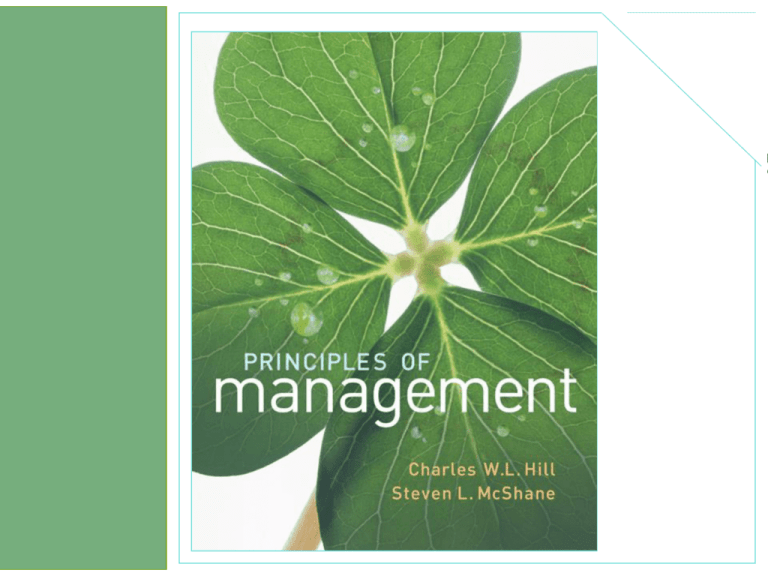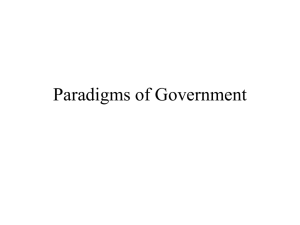
chapter
18
Managing Innovation
and Change
McGraw-Hill/Irwin
Principles of Management
© 2008 The McGraw-Hill Companies, Inc., All Rights Reserved.
18 - 3
Learning Objectives
1. Explain how paradigm shifts occur and describe their
consequences.
2. A. Identify the major sources of organizational inertia.
3. Outline what is required to change the strategy and
organization of an established enterprise.
4. Explain why many organizational change efforts fail and
identify what managers can do to avoid failure.
5. Discuss what managers can do to increase the ability of
their organization to produce commercially successful
innovations.
18 - 4
Paradigm Shifts
• Occurs when a new technology or business model comes
along that dramatically alters the nature of demand and
competition
• Disruptive technology – A new technology that gets its
start away from the mainstream of a market and then, as
its functionality improves, invades the main market
• Punctuated equilibrium – A view of industry evolution
asserting that long periods of equilibrium are punctured
by periods of rapid change when industry structure is
revolutionized by innovation
18 - 5
Performance/functionality
of desired attributes
Technology S-Curves
Natural limit of technology
Probability of
paradigm shift
increases as technology
approaches natural
limit.
Diminishing returns
Inflection point
Increasing returns
Accumulated R&D effort
18 - 6
Established technology:
horse and cart
Paradigm shift
Performance/functionality
of desired attributes
Established and
Successor Technologies
Successor technology
automobiles
T1
T2
Time
18 - 7
Discontinuity
Performance/functionality
of desired attributes
Swarm of Successor
Technologies
Swarm of successor
technologies
Time
Five Steps to
a Creative Company
1. Technology and information become commoditized and
globalized
2. With commoditization, core advantages can be shipped
abroad
3. Design strategy begins to replace Six Sigma as a key
organizing principle
4. Creative innovation becomes the key drive of growth
5. The successful Creative Corporation emerges, with new
Innovation DNA
Source: Business Week, August 1, 2005
18 - 8
Top 5 Innovative
Companies in the World
• 2005 Poll of 940 senior executives in 68 countries by Boston
Consulting Group
Company
• Apple
• 3M
• Microsoft
• GE
• Sony
Source: Business Week, August 1, 2005
Responses
24.84%
11.77%
8.53%
8.53%
5.94%
18 - 9
18 - 10
New Business Model
• The way in which an enterprise intends to make
money
- Can rapidly alter the competitive playing field/create a
paradigm shift
- Can be created due to technological innovation, or the
absence of technology all together
Drivers of Change
in Business Schools
Drivers
1.
2.
3.
4.
5.
Doctoral faculty shortage
Emergence of new competition
Shifts in funding sources
Rapid changes in the economy
Changes in how business organizations function
Source: Biz Ed, March/April, 2002
18 - 11
%Yes
52%
47%
46%
38%
33%
18 - 12
Punctuated Equilibrium
Period
Stable
of Change Period
Industry structure
Stable
Period
Industry becomes
more consolidates
again, but different
firms now lead the
market.
Change is triggered
by the emergence of
new technology.
New entry results in
a more fragmented
industry.
t0
t1
t2
Time
18 - 13
Organizational Inertia
Internal and external forces that make it difficult to change the
strategy or organization architecture of an enterprise
Cognitive
Schemata
Internal
Political
Constraints
Commitments
& Capabilities
Organizational
Culture
External
Institutional
Constraints
18 - 14
Question
In the 1980s, International Videos (IV) had major
global investments in the video cassette and video
cassette recorders (VCR) business. When the market
shifted toward CDs and DVDs, IV was stuck with
significant assets in the declining VCR business.
This is an example of which inertia force?
a. Cognitive schemata
b. Internal political constraint
c. Organizational culture
d. Commitments and capabilities
The Process of
Organizational Change
Leadership committed to change
Unfreezing the
organization
Requires:
*Shock therapy
*Compelling case
for change
*Compelling vision
18 - 15
Requires:
*Outside or “inside-outsider”
*Leading by example
Moving the
organization
Requires:
*Decisive action
*Committed mgmt team
*New strategy
*Asset disposals
*New org. architect
*Cultural change effort
*Employee involvement
Refreezing the
organization
Requires:
*Multi-year perspective
*Constant pressure
*Ongoing socialization
*Consistent application
of new organization
architecture
Failed Change Efforts
& the Secrets of Success
18 - 16
1. They do not establish a great sense of urgency
2. They do not create a powerful enough
coalition to push through the change
3. They lack a compelling vision
4. If they do have a vision, they poorly
communicate it to others
Failed Change Efforts
& the Secrets of Success
18 - 17
5. They fail to remove obstacles to the change
effort
6. They fail to plan for or create short-term wins
7. They declare victory too soon
8. They fail to empower employees and lower-level
managers to implement the change
18 - 18
Driving Innovation
• Quantum innovations – Innovations that incorporate
new technology and disrupt competition, shifting the
dominant paradigm
• Incremental innovations – innovations that represent
improvements in product functionally within an
established technology
18 - 19
Always Something New
PepsiCo and its Frito-Lay unit offer products
for every taste and ethnic market
Number of new
products in
PepsiCo portfolio
last year
200+
Source: Business Week, June 14, 2004
Increase in
PepsiCo earnings
in 2003 over
previous year
19%
18 - 20
New Product Failures
New products fail because:
• The demand for innovations is inherently uncertain
• The technology is poorly commercialized
• Poor strategy, including inappropriate pricing, weak
promotion, or poor distribution strategy
• Companies often market a technology for which there is
not enough demand
Innovation’s Dismal
Success Rate
All industry innovation initiative success rate is 4.5%
Industry
• Toys
• Groceries
• Music
• Airlines
• Mobile telephony
Source: Business Week, August 1, 2005
Success Rate
>1%
>2%
>2%
2%
3%
18 - 21
18 - 22
A Formula for Failure
1.
2.
3.
4.
5.
6.
Formalize forums for failure
Move the Goalposts
Share personal stories
Bring in outsiders
Prove yourself wrong, not right
Celebrate smart failures
“It’s innovation’s great paradox: Success—that is, true
breakthroughs—usually comes through failure.”
Source: Business Week, July 10, 2006
Generating Successful
Innovations
• Build skills in basic and applied scientific research
• Developing a good process for project selection and
project management
• Using cross-functional integration
• Creating product development processes
• Implementing partly parallel development processes
• Placing a radically new technology in an autonomous
organization unit
18 - 23
18 - 24
Phase 2:
Project
Refinement
Gate 2
Phase 1: Idea
Generation
Gate 1
A Development Funnel
Phase 3: Project
Execution
Market
18 - 25
Cross Functional Integration
• Product development projects are
driven by customer needs
• New products are designed for ease
of manufacture
• Development costs are kept in
check
• Time to market is minimized
18 - 26
Product Development Teams
To function effectively:
1. A heavyweight project manager should lead the team and be
dedicated primarily to the project
2. The team should have at least one member from each key function
3. The team members should be physically collocated to create a sense
of camaraderie and facilitate communication
4. Have a clear plan and clear goals , particularly for critical
development milestones and development budgets
5. Each team needs to develop processes for communication and
conflict resolution
18 - 27
A Sequential Process
Opportunity
identification
Process
design
Concept
development
Product
design
Commercial
production
18 - 28
A Partly Parallel Process
Opportunity
identification
Concept
development
Product
design
Process
design
Commercial
production
18 - 29
Question
When a firm develops a
quantum innovation — one
that might usher in a
technological paradigm shift in
the industry — it should not be
introduced to the market
because of the certainty of selfcannibalization. Do you agree?
Explain.









